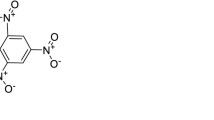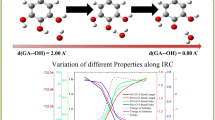Abstract
Polyphenols are amply present in fruits, vegetables, beverages and thus very common items in our diet. They are better characterized as antioxidants and are able to scavenge various radicals and singlet oxygen. The present study aims to provide structural and electronic insight into the antioxidant activity of polyphenols and identify novel natural antioxidant. With systematic searches of the large descriptor spaces available in CODESSA, we found that number of benzene ring (constitutional descriptors), electrostatic descriptors related to the hydrogen bonding ability and the lowest unoccupied molecular orbital (LUMO) energy of the polyphenols are very important descriptors related to the electron donation ability of polyphenols, evident from t test values and principal component analysis. Decreasing LUMO energy facilitates electron transfer and stability of the resulting polyphenolic radical increases with the number of attached aromatic ring due to enhanced resonance. Hydrogen bonding present in the parent polyphenol also facilitates electron donation and stabilizes the phenolic radical. Using multiple linear regressions, we have derived two quantitative structure activity relation (QSAR) models with four and five descriptors, respectively, and validated using cross-validation techniques. The calculated square correlation coefficient for four and five descriptor models is R 2 = 0.89 and R 2 = 0.9, respectively, with cross-validated squared correlation coefficient \({R}_{\text{CV}}^{2}\) = 0.83 and \({R}_{\text{CV}}^{2}\) = 0.87, respectively. Virtual screening using the derived QSAR models on in-house developed phytochemical database identified several highly potent natural antioxidants exhibiting their activity by electron donation coupled proton transfer pathway.



Similar content being viewed by others
References
Martin KR, Appel CL (2010) Polyphenols as dietary supplements: a double-edged sword. Nutr Diet Suppl 2:1–12
Cushnie TP, Lamb AJ (2011) Recent advances in understanding the antibacterial properties of flavonoids. Intl J Antimicrob Agents 38:99–107
Jäger AK, Saaby L (2011) Flavonoids and the CNS. Molecules 16:1471–1485
Nagaprashantha LD, Vatsyayan R, Singhal J, Fast S, Roby R, Awasthi S, Singhal SS (2011) Anti-cancer effects of novel flavonoid vicenin-2 as a single agent and in synergistic combination with docetaxel in prostate cancer. Biochem Pharmacol 82:1100–1109
Frei B (1995) Cardiovascular disease and nutrient antioxidants: role of low-density lipoprotein oxidation. Crit Rev Food Sci Nutr 35:83–98
Gei KF (1995) Ten-year retrospective on the antioxidant hypothesis of arteriosclerosis. Nutr Biochem 6:206–236
Ingram D, Sanders K, Kolybaba M, Lopez M (1997) Case–control study of phytoestrogens and breast cancer. Lancet 9083:990–994
Chun OK, Kim DO, Lee CY (2003) Superoxide radical scavenging activity of the major polyphenols in fresh plums. J Agric Food Chem 51:8067–8072
Katiyar SK, Afaq F, Perez A, Mukhtar H (2001) Green tea polyphenol (–)-epigallocatechin-3-gallate treatment of human skin inhibits ultraviolet radiation-induced oxidative stress. Carcinogenesis 22(2):287–294
Lopes GK, Schulman HM, Hermes-Lima M (1999) Polyphenol tannic acid inhibits hydroxyl radical formation from Fenton reaction by complexing ferrous ions. Biochim et Biophys Acta 1472:142–152
Wei H, Zhang X, Zhao JF, Wang ZY, Bickers D, Lebwohl M (1999) Scavenging of hydrogen peroxide and inhibition of ultraviolet light-induced oxidative DNA damage by aqueous extracts from green and black teas. Free Radic Biol Med 26:1427–1435
Choi JS, Chung HY, Kang SS, Jung MJ, Kim JW, No JK, Jung HA (2002) The structure–activity relationship of flavonoids as scavengers of peroxynitrite. Phytother Res 16:232–235
Bandyopadhyay U, Das D, Banerjee RK (1999) Reactive oxygen species: oxidative damage and pathogenesis. Curr Sci 77:658–666
Sanderson TH, Reynolds CA, Kumar R, Przyklenk K, Hüttemann M (2013) Molecular mechanisms of ischemia–reperfusion injury in brain: pivotal role of the mitochondrial membrane potential in reactive oxygen species generation. Mol Neurobiol 47:9–23
Roginsky V, Lissi EA (2005) Review of methods to determine chain-breaking antioxidant activity in food. Food Chem 92:235–254
Dudonne S, Vitrac X, Coutiere P, Woillez M, Mérillon JM (2009) Comparative study of antioxidant properties and total phenolic content of 30 plant extracts of industrial interest using DPPH, ABTS, FRAP, SOD, and ORAC assays. J Agric Food Chem 57:1768–1774
Sarkar A, Middya TR, Jana AD (2012) A QSAR study of radical scavenging antioxidant activity of a series of flavonoids using DFT based quantum chemical descriptors—the importance of group frontier electron density. J Mol Model 18:2621–2631
Pahari B, Chakraborty S, Chaudhuri S, Sengupta B, Sengupta PK (2012) Binding and antioxidant properties of therapeutically important plant flavonoids in biomembranes: insights from spectroscopic and quantum chemical studies. Chem Phys Lipids 165:488–496
Amic D, Davidovic-Amic D, Beslo D, Rastija V, Lucic B, Trinajstic N (2007) SAR and QSAR of the antioxidant activity of flavonoids. Curr Med Chem 14:827–845
Ghiotto RCT, Lavarda FC, Ferreira FJB (2004) Antioxidant activity of flavonols. Intl J Quantum Chem 97:949–952
Farkas O, Jakus J, Héberger K (2004) Quantitative structure–antioxidant activity relationships of flavonoid compounds. Molecules 9:1079–1088
Weber KC, Honório KM, Da Silva SL, Mercadante R, Da Silva ABF (2005) Selection of quantum chemical descriptors by chemometric methods in the study of antioxidant activity of flavonoid compounds. Intl J Quantum Chem 103:731–737
CODESSA [computer program] (1995) Version 2.7.16. Comprehensive descriptor for structure and statistical analysis. Copyright center of heterocyclic chemistry, University of Florida and institute of chemical physics, University of Tartu, Estonia and SemiChem Inc
Cai YZ, Sun M, Xing J, Luo Q, Corke H (2006) Structure–radical scavenging activity relationships of phenolic compounds from traditional Chinese medicinal plants. Life Sci 78:2872–2888
Soobrattee MA, Neergheen VS, Luximon-Ramma A, Aruoma OI, Bahorun T (2005) Phenolics as potential antioxidant therapeutic agents: mechanism and actions. Mut Res 579:200–213
Hyperchem (2002) Hypercube, Inc., USA
AMPAC 9.0, © (1994) Semichem, 7128 Summit, Shawnee, KS 66216
Ai Y, Wang ST, Sun PH, Song FJ (2011) Combined 3D-QSAR modeling and molecular docking studies on Pyrrole-Indolin-2-ones as Aurora A Kinase inhibitors. Intl J Mol Sci 12:1605–1624
Chakraborty S, Biswas PK (2012) Elucidation of the mechanistic pathways of the hydroxyl radical scavenging reaction by Daidzein using hybrid QM/MM dynamics. J Phys Chem A 116:8775–8785
Acknowledgments
The authors would like to acknowledge West Bengal University of Technology for allowing usage of the CODESSA software package. SB gratefully acknowledges financial support from Department of Science and Technology, Govt. of India and Department of Science and Technology Govt. of West Bengal.
Conflict of interest
None.
Compliance with Ethics Requirements
This article does not contain any studies with human or animal subjects.
Author information
Authors and Affiliations
Corresponding authors
Electronic supplementary material
Below is the link to the electronic supplementary material.
Rights and permissions
About this article
Cite this article
Chakraborty, S., Basu, S. Mechanistic insight into the radical scavenging activity of polyphenols and its application in virtual screening of phytochemical library: an in silico approach. Eur Food Res Technol 239, 885–893 (2014). https://doi.org/10.1007/s00217-014-2285-x
Received:
Revised:
Accepted:
Published:
Issue Date:
DOI: https://doi.org/10.1007/s00217-014-2285-x




